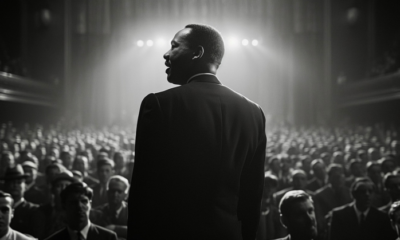Life
4 Steps to Take Right Now to Snap Out of Your Funk
Maybe you’re spending sleepless nights tossing and turning in bed, or perhaps you’re sleeping in until noon. Maybe all you hear are the sad songs, and all you think of are the terrible things that are happening.
You’re in a funk. Everyone goes through their funk sometime in their life. You could feel helpless in a business or career you’re trying to build, from losing your job, or having a broken heart. Whatever it is, you just need some help to get out of your funk.
From my experience as a life coach seeing thousands of people get out of their funk, the steps described below have helped CEO’s, entrepreneurs, parents and all sorts of people go and conquer what they wanted.
This works for a variety of people in different situations. If you want to get out of your funk, you’ve got to give this visualization exercise a go.
Before we go into it, you’ll need to prepare these three ingredients:
- The Map – There’s a situation or experience in your life that is related to this funk. Whatever situation or experience this is, let’s refer to it as your current map of your world.
- A Navigator – You’re going to go into an imaginary “flight”. And you’ll need someone with good eyes, good sense of humor and a good heart to guide you in your flight. Your co-pilot needs to be someone you respect. Identify your navigator.
- A Treasure – This is something that is valuable and will be useful for the person who will use it.
“Happiness is an attitude. We either make ourselves miserable, or happy and strong. The amount of work is the same.” – Francesca Reigler
Now, are you ready to get out of your funk? Here are the four steps you need to follow today:
1. Size up
Get into the map. See yourself inside the map, whether it’s the situation that triggered your funk, or the resulting funk that you might be in. You must size up the situation and acknowledge whatever it is that you’re feeling when you’re in the situation. Describe what it’s like to be inside this map. Acknowledge it as it is, then take full responsibility for whatever it is that’s in your funk.
2. Step Out
Get outside of the map, get outside of the funk. Now, in your mind, see the map from afar. Let’s take it to another level. Imagine that you’re stepping into the point of view of a flying drone and a camera. Imagine yourself hovering above the situation that put you in this funk. You have full control of the drone, so go ahead and go around the situation from the perspective of the drone. Describe what you see from outside the map as you are flying over the map.
3. See differently
Now, you’re going to call in your co-pilot. When your co-pilot joins your flight above the map, they will advise you on which aspects of the map you will want to look at differently. Go ahead, look at things from a different point of view as advised to you by your co-pilot. Describe what you see from the different points of view your co-pilot is guiding you through.
“What is a friend? A single soul dwelling in two bodies.” – Aristotle
4. Search for Treasure
Being in full control of what you choose to see and with the help of your navigator’s guidance, go ahead and navigate around the map searching for treasure. Somewhere in there is something valuable you might have missed before. What has the experience taught you to be? What has the experienced given you? What has the situation brought out from you?
This is like a treasure hunt. From amidst the flurry that’s happening in the funk, there is a treasure that you and your navigator can find for yourself. Your treasure can be a new perspective, new insight, new feeling, or renewed courage. It could be anything that is useful for you, a treasure that you will use to get out of the funk.
Now that you’ve found some treasures, go ahead and go back into the map and get your treasures. It’s been there all along, as you must find it. You just have to claim it for yourself. The treasure you found is all within you for the taking so own it. Whatever the treasure is, make sure you take action and make it real.
What action can you start doing differently today in order to make a difference n your life? Comment below and let us know!
Image courtesy of Twenty20.com
Did You Know
How Skilled Migrants Are Building Successful Careers After Moving Countries
Behind every successful skilled migrant career is a mix of resilience, strategy, and navigating systems built for locals.

Moving to a new country for work is exciting, but it can also be unnerving. Skilled migrants leave behind familiar systems, networks, and support to pursue better job opportunities and a better future for their families. (more…)
Life
10 Research-Backed Steps to Create Real Change This New Year
This New Year could finally be the one where you break old patterns and create real, lasting change.

Every New Year, we make plans and set goals, but often repeat old patterns. (more…)
Life
9 Harsh Truths Every Young Man Must Face to Succeed in the Modern World
Before chasing success, every young man needs to face these 9 brutal realities shaping masculinity in the modern world.

Many young men today quietly battle depression, loneliness, and a sense of confusion about who they’re meant to be.
Some blame the lack of deep friendships or romantic relationships. Others feel lost in a digital world that often labels traditional masculinity as “toxic.”
But the truth is this: becoming a man in the modern age takes more than just surviving. It takes resilience, direction, and a willingness to grow even when no one’s watching.
Success doesn’t arrive by accident or luck. It’s built on discipline, sacrifice, and consistency.
Here are 9 harsh truths every young man should know if he wants to thrive, not just survive, in the digital age.
1. Never Use Your Illness as an Excuse
As Dr. Jordan B. Peterson often says, successful people don’t complain; they act.
Your illness, hardship, or struggle shouldn’t define your limits; it should define your motivation. Rest when you must, but always get back up and keep building your dreams. Motivation doesn’t appear magically. It comes after you take action.
Here are five key lessons I’ve learned from Dr. Peterson:
-
Learn to write clearly; clarity of thought makes you dangerous.
-
Read quality literature in your free time.
-
Nurture a strong relationship with your family.
-
Share your ideas publicly; your voice matters.
-
Become a “monster”, powerful, but disciplined enough to control it.
The best leaders and thinkers are grounded. They welcome criticism, adapt quickly, and keep moving forward no matter what.
2. You Can’t Please Everyone And That’s Okay
You don’t need a crowd of people to feel fulfilled. You need a few friends who genuinely accept you for who you are.
If your circle doesn’t bring out your best, it’s okay to walk away. Solitude can be a powerful teacher. It gives you space to understand what you truly want from life. Remember, successful men aren’t people-pleasers; they’re purpose-driven.
3. You Can Control the Process, Not the Outcome
Especially in creative work, writing, business, or content creation, you control effort, not results.
You might publish two articles a day, but you can’t dictate which one will go viral. Focus on mastery, not metrics. Many great writers toiled for years in obscurity before anyone noticed them. Rejection, criticism, and indifference are all part of the path.
The best creators focus on storytelling, not applause.
4. Rejection Is Never Personal
Rejection doesn’t mean you’re unworthy. It simply means your offer, idea, or timing didn’t align.
Every successful person has faced rejection repeatedly. What separates them is persistence and perspective. They see rejection as feedback, not failure. The faster you learn that truth, the faster you’ll grow.
5. Women Value Comfort and Security
Understanding women requires maturity and empathy.
Through books, lectures, and personal growth, I’ve learned that most women desire a man who is grounded, intelligent, confident, emotionally stable, and consistent. Some want humor, others intellect, but nearly all want to feel safe and supported.
Instead of chasing attention, work on self-improvement. Build competence and confidence, and the rest will follow naturally.
6. There’s No Such Thing as Failure, Only Lessons
A powerful lesson from Neuro-Linguistic Programming: failure only exists when you stop trying.
Every mistake brings data. Every setback builds wisdom. The most successful men aren’t fearless. They’ve simply learned to act despite fear.
Be proud of your scars. They’re proof you were brave enough to try.
7. Public Speaking Is an Art Form
Public speaking is one of the most valuable and underrated skills a man can master.
It’s not about perfection; it’s about connection. The best speakers tell stories, inspire confidence, and make people feel seen. They research deeply, speak honestly, and practice relentlessly.
If you can speak well, you can lead, sell, teach, and inspire. Start small, practice at work, in class, or even in front of a mirror, and watch your confidence skyrocket.
8. Teaching Is Leadership in Disguise
Great teachers are not just knowledgeable. They’re brave, compassionate, and disciplined.
Teaching forces you to articulate what you know, and in doing so, you master it at a deeper level. Whether you’re mentoring a peer, leading a team, or sharing insights online, teaching refines your purpose.
Lifelong learners become lifelong leaders.
9. Study Human Nature to Achieve Your Dreams
One of the toughest lessons to accept: most people are self-interested.
That’s not cynicism, it’s human nature. Understanding this helps you navigate relationships, business, and communication more effectively.
Everyone has a darker side, but successful people learn to channel theirs productively into discipline, creativity, and drive.
Psychology isn’t just theory; it’s a toolkit. Learn how people think, act, and decide, and you’ll know how to lead them, influence them, and even understand yourself better.
Final Thoughts
The digital age offers endless opportunities, but only to those who are willing to take responsibility, confront discomfort, and keep improving.
Becoming a man today means embracing the hard truths most avoid.
Because at the end of the day, success isn’t about luck. It’s about who you become when life tests you the most.
Change Your Mindset
The Four Types of Happiness: Which One Are You Living In?
Most people chase success only to find emptiness, this model reveals why true happiness lies somewhere else.

In a world driven by rapid technological growth and constant competition, many people unknowingly trade joy for achievement. (more…)
-

 Entrepreneurs4 weeks ago
Entrepreneurs4 weeks agoThe Essential Skills Every Entrepreneur Needs In 2026
-

 Change Your Mindset3 weeks ago
Change Your Mindset3 weeks agoHow to Turn Your Mind Into Your Greatest Asset (Instead of Your Enemy)
-

 Change Your Mindset3 weeks ago
Change Your Mindset3 weeks agoThe Silent Skill That Makes People Respect You Instantly
-

 Life2 weeks ago
Life2 weeks ago10 Research-Backed Steps to Create Real Change This New Year
-

 Tech2 weeks ago
Tech2 weeks agoWhat’s in a Name? How to Get Your Domain Right
-

 Did You Know2 weeks ago
Did You Know2 weeks agoHow Skilled Migrants Are Building Successful Careers After Moving Countries

























2 Comments